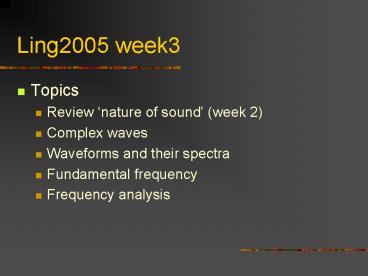Ling2005 week3 PowerPoint PPT Presentation
1 / 14
Title: Ling2005 week3
1
Ling2005 week3
- Topics
- Review nature of sound (week 2)
- Complex waves
- Waveforms and their spectra
- Fundamental frequency
- Frequency analysis
2
Review Week 2 Preliminaries Acoustic Phonetics
- Sound waves and barometric pressure waves
Differences? - Compare with regard to wavelength, velocity,
period, frequency. - Define pressure.
- Force per unit area
- Why do we need a medium for sound?
- Sound transmission relies on kinetic energy of
particles in a medium - Descriptive terms for sound quality?
- Pleasant noisy, mellow harsh, .
- Three ways of classifying sounds/signals?
- Periodic/aperiodic, transient/continuous,
simple/complex
3
Review continued
- Properties of waves
- Amplitude
- Displacement from baseline arbitrary unit but
see decibels - Period
- Time between wave fronts Measured in
milliseconds - Frequency
- Number of repeats per unit time. Measured in Hz
- Auditory and acoustic dimensions of sound
- Perceptual versus physical properties.
- Pitch frequency
- Loudness Pressure or Intensity
- Quality/Timbre distribution of spectral energy.
4
Perceptual and acoustic properties of English
consonants
- How may we map perceptual relations between
speech sounds? - Obtaining similarity judgments
- Mapping perceptual distances multi-dimensional
scaling. - What features might be responsible for clustering
the sounds in perceptual space? - The X-axis?
- Stimulus duration (time)?
- The Y-axis?
- A resonance/sonority vs noise/hiss dimension?
- Correlates with manner of articulation
- Are these general auditory properties of sounds
or are they specific to sounds of speech
(phonetic properties)?
5
Waveform and spectrum
- There are two complementary ways of looking at
signals - As a waveform in the time domain
- As a spectrum in the frequency domain
- Consider this sound
- What kind of sound is it?
- Can you guess its frequency?
6
A simple (sinusoidal) wave
- Its waveform
- Its spectrum
7
The spectrum
- A waveform shows amplitude fluctuations in a
signal over time. - A spectrum shows the distribution of frequency
(energy) components present in a signal - their relative strength (magnitude) and where
they are located in the frequency domain. - A spectrum is a snapshot of the energy of the
signal at a particular point in time
(instantaneous spectrum), - Or the average energy present over a period of
time (the long-term spectrum). - In practical terms, a spectrum must always be
computed over some minimal time period (Hence the
instantaneous spectrum is an idealization.
8
Spectra of complex signals
- What is a complex signal?
- One with more than a single frequency component.
- This is a (minimally) complex signal
9
Notes on previous slide
- How many periods are highlighted in the waveform?
- How many frequency components are present in the
spectrum? - Two
- What are their respective frequencies?
- 170 Hz and (approximately) 240 Hz.
- On the lower part of the spectrum we see spectral
time window over which the spectrum was
calculated. - How many periods of the signal are captured in
the spectral window? - Approximately four.
- The spectral window has a certain shape
(envelope). The envelope indicates the weighting
applied at each time point about the centre of
the spectral window. How would you describe the
shape of the window? - Like a normal curve (Gaussian).
10
More waves and their spectra
- Recall the sounds we examined last week?
- The buzz
11
Notes on previous slide
- The buzz is made up of a series of rapid clicks
(pops). - The time between clicks defines its Period and
(fundamental) Frequency. - From the spectrum, you see that the buzz has many
frequency components. - Each of these components occurs at a regular
frequency interval. - This frequency interval corresponds to the
frequency of repetition of the waveform. It is
known as the fundamental frequency of the
signal.
12
White noise
- A continuous, aperiodic signal.
- Has a continuous spectrum an infinite number of
frequency components. - Has no fundamental frequency.
13
A quasi-periodic signal
- This sounds like a sinusoid in noise.
- A composite signal with periodic and aperiodic
components
14
Questions on previous slide
- Can you distinguish the periodic and the
aperiodic components of this signal on the
spectrum? - Does this signal have a fundamental frequency?
- If so, what is that frequency?
- Ans 366 Hz.

